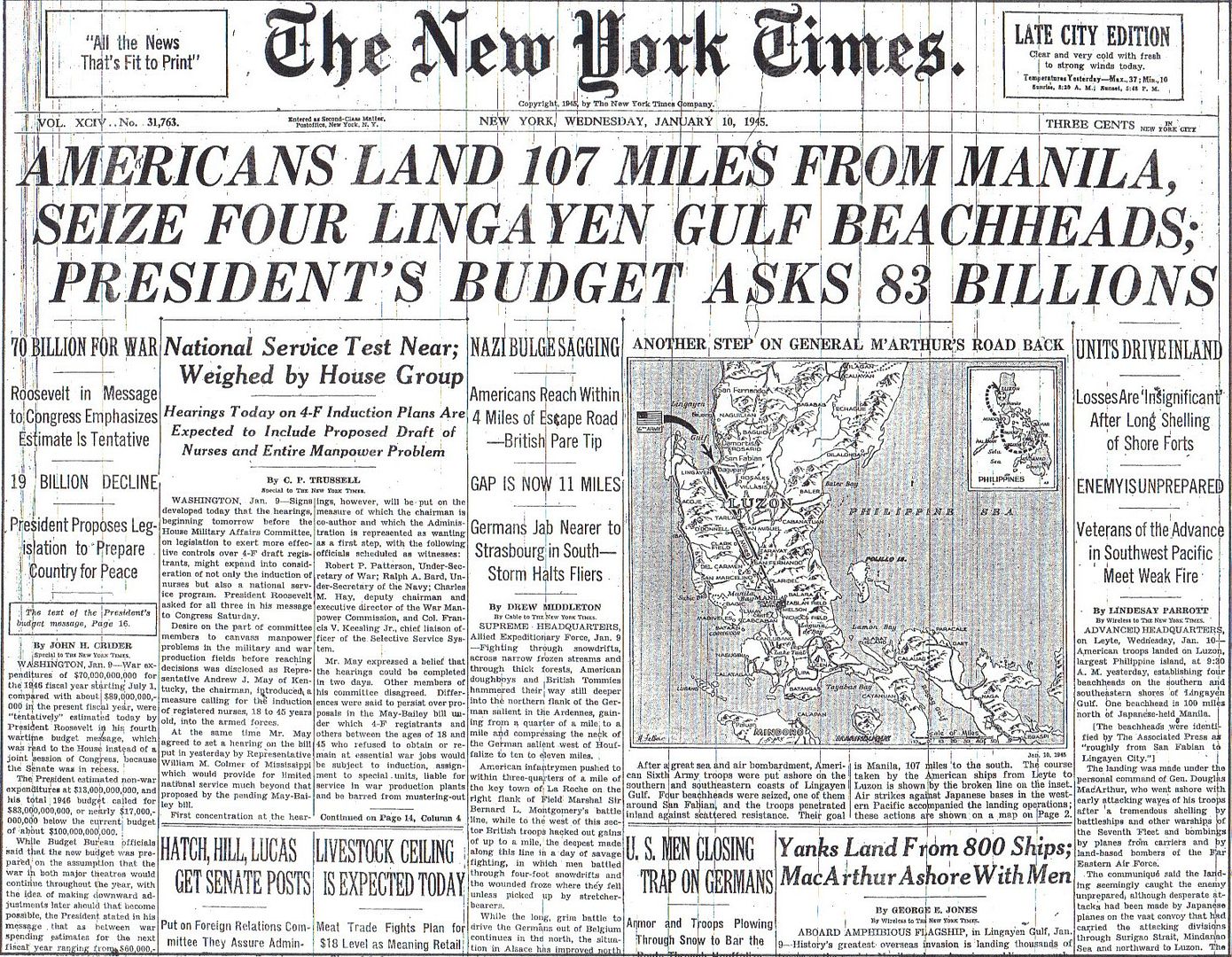
Posted on 01/10/2015 4:54:00 AM PST by Homer_J_Simpson

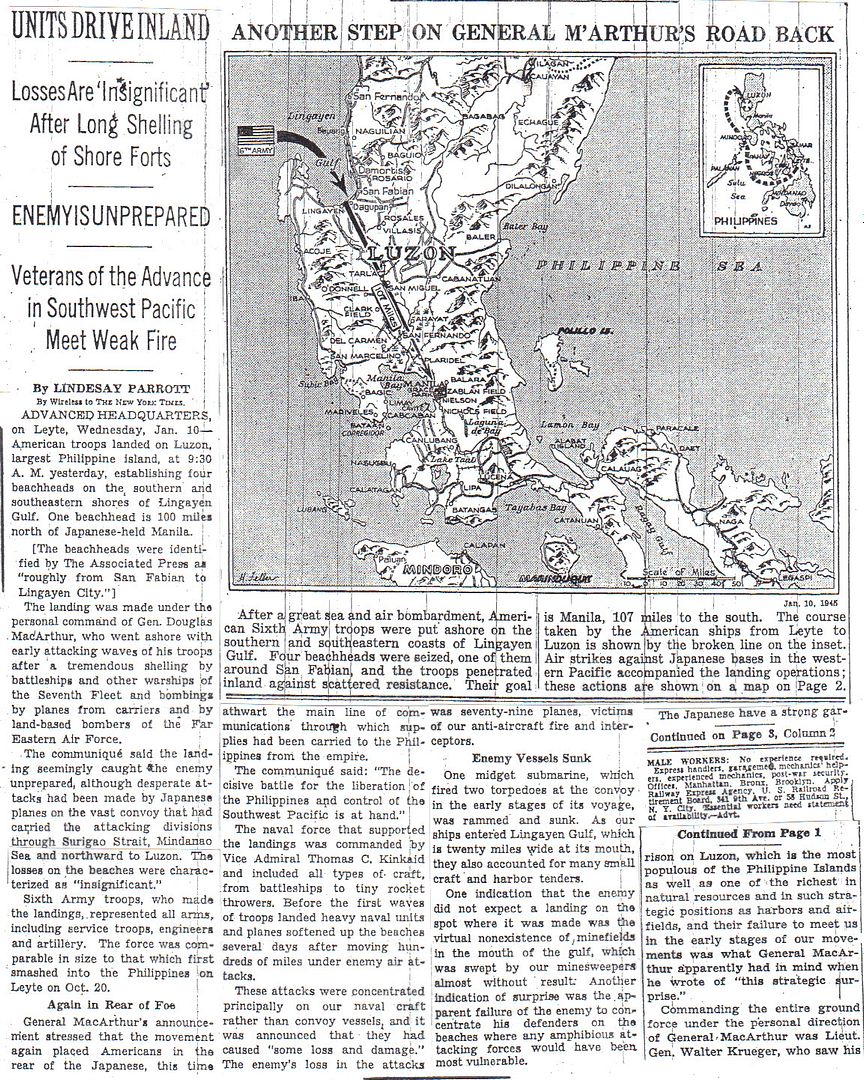

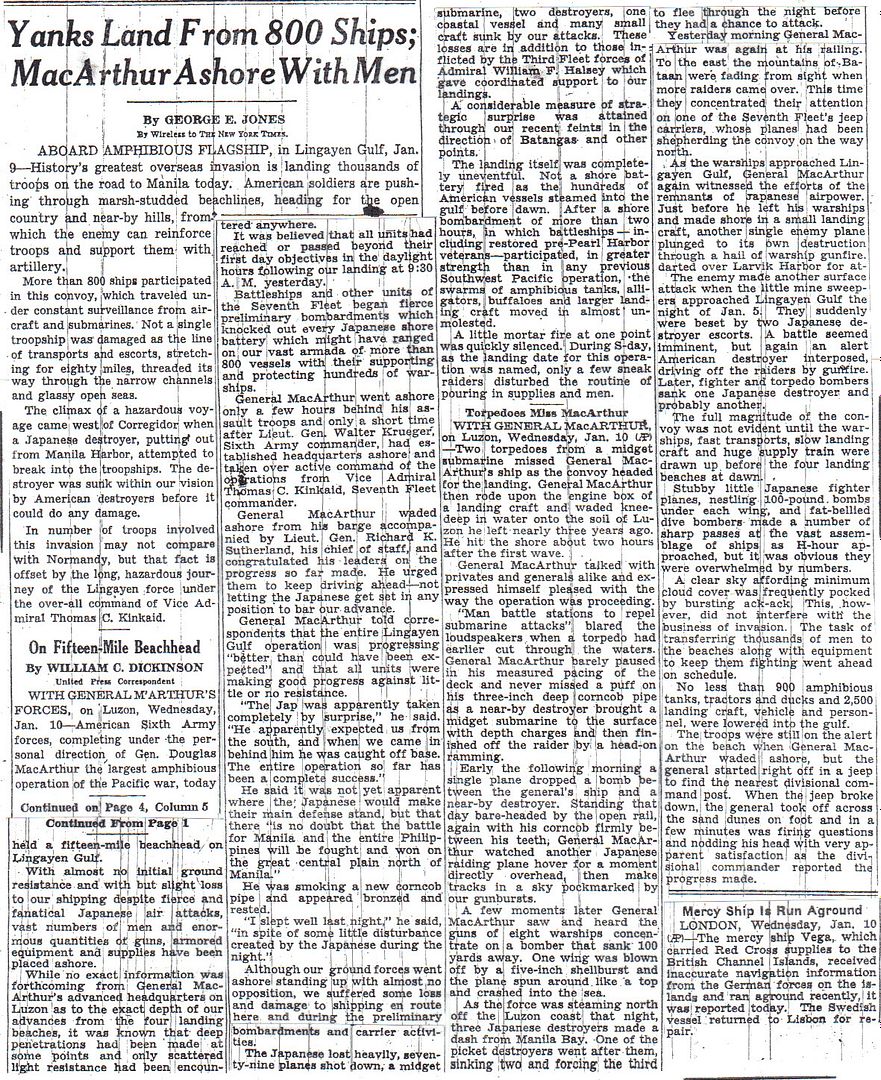
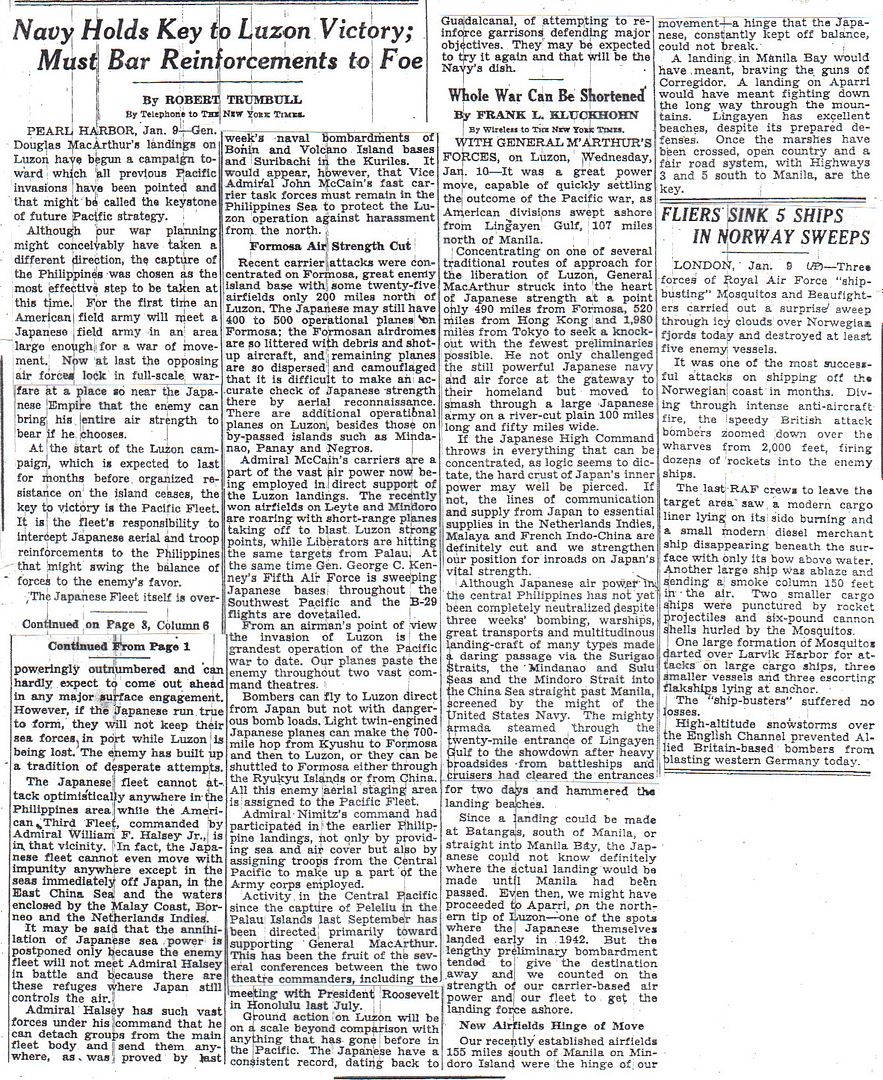
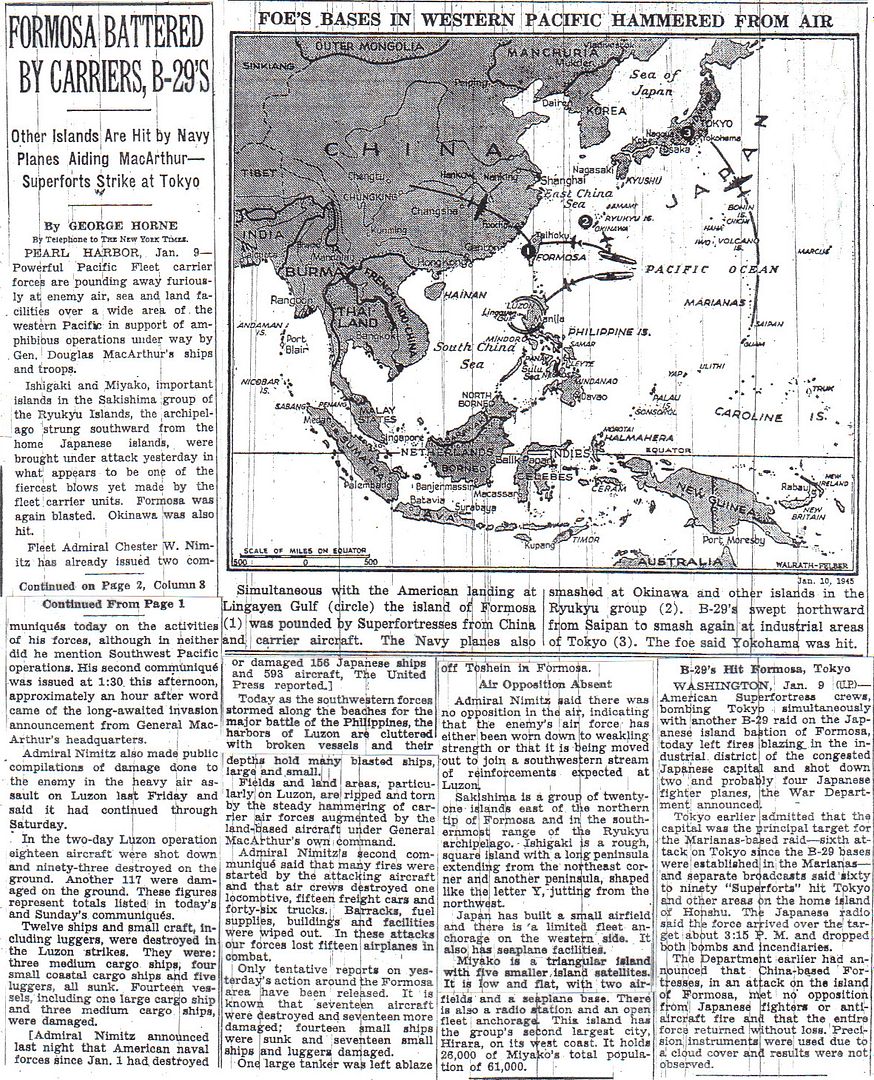

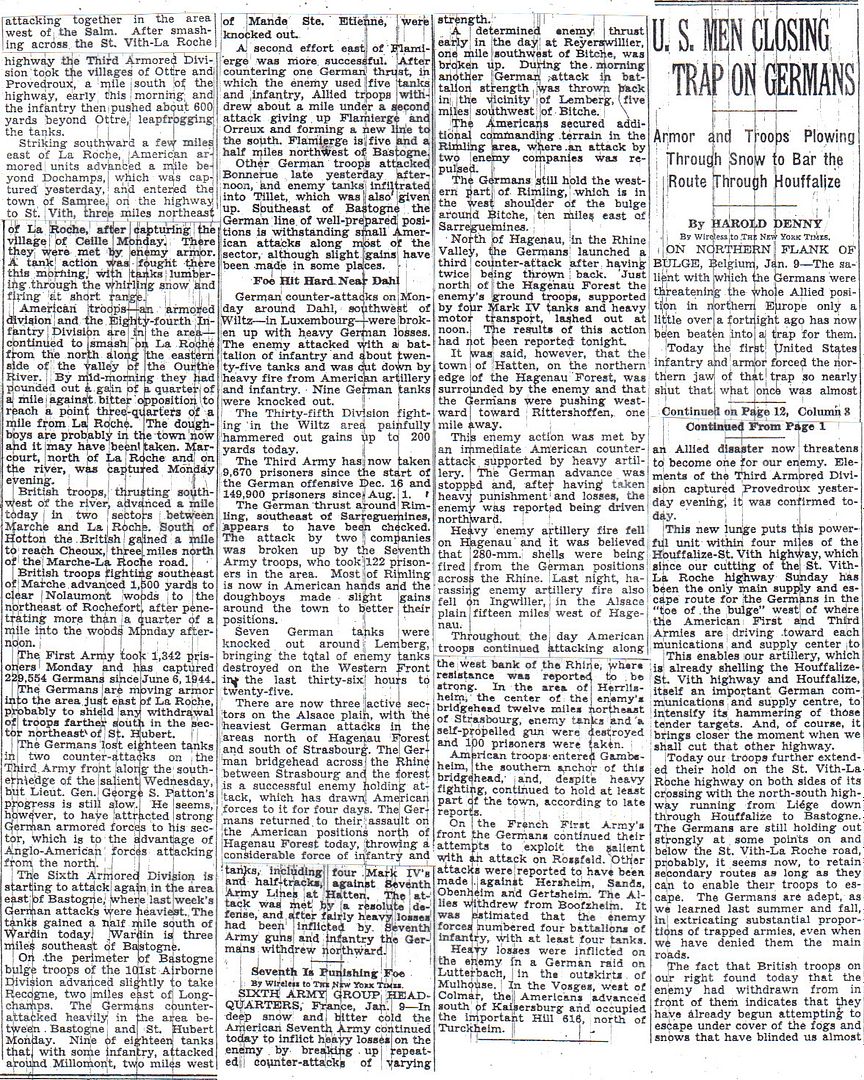
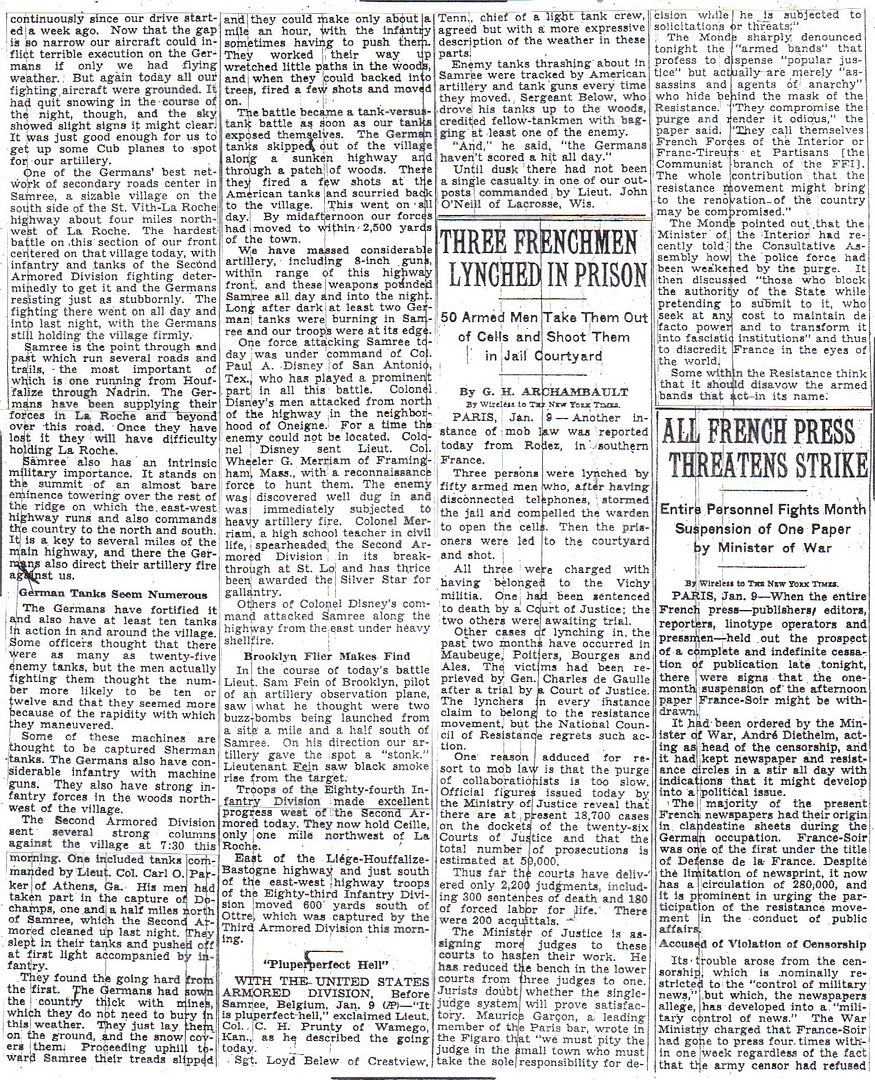

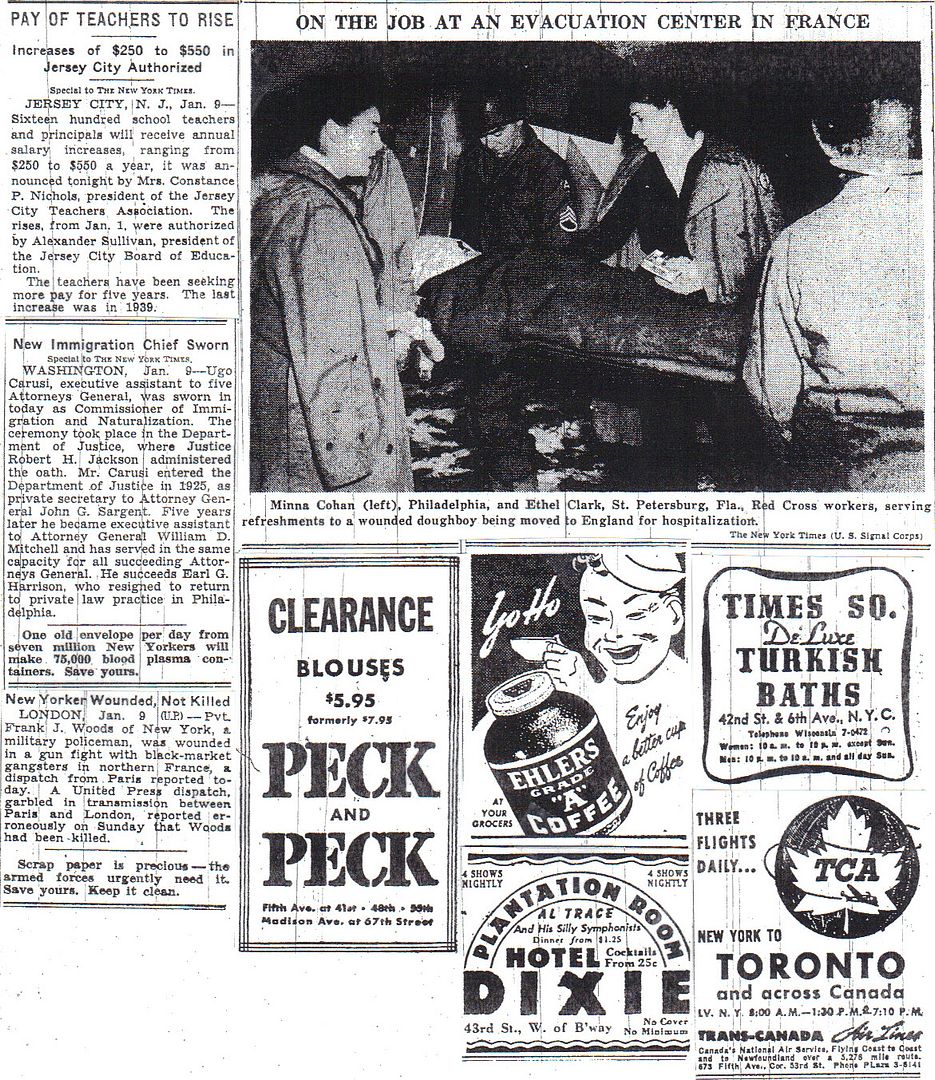
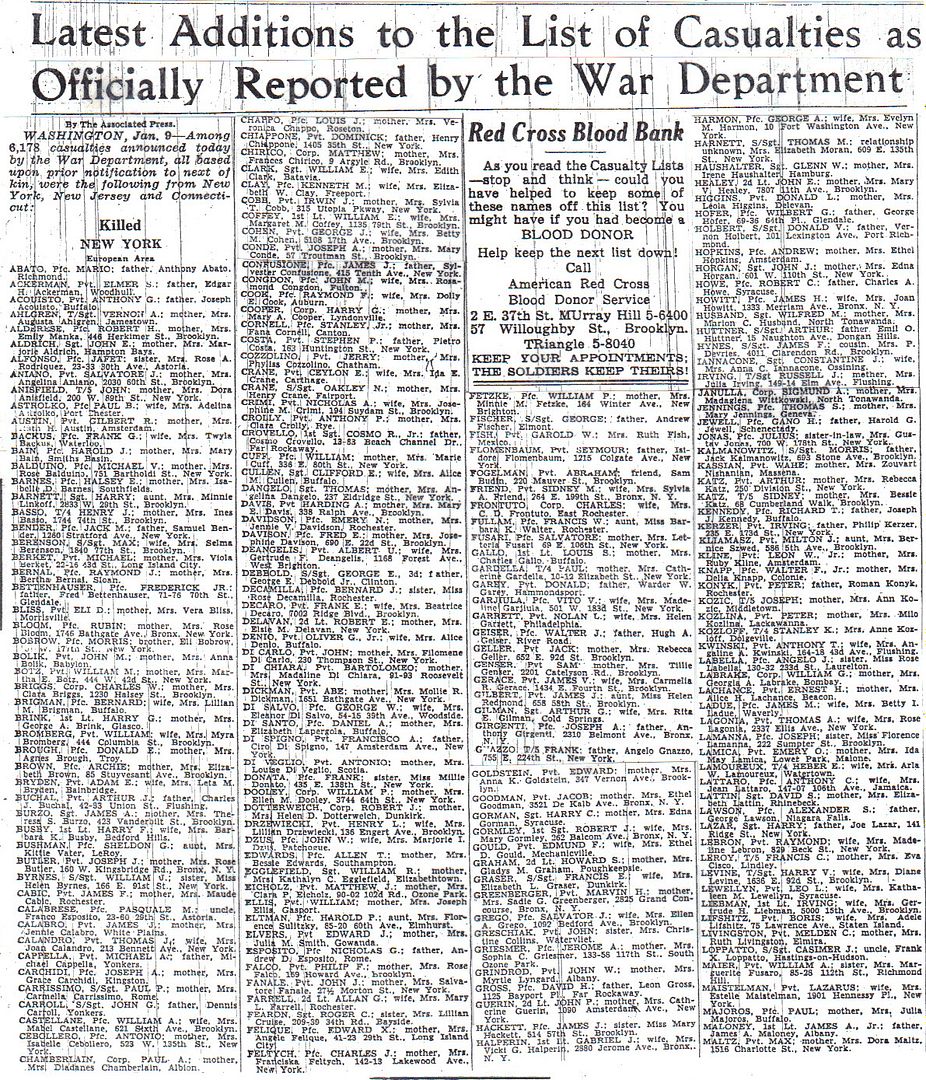
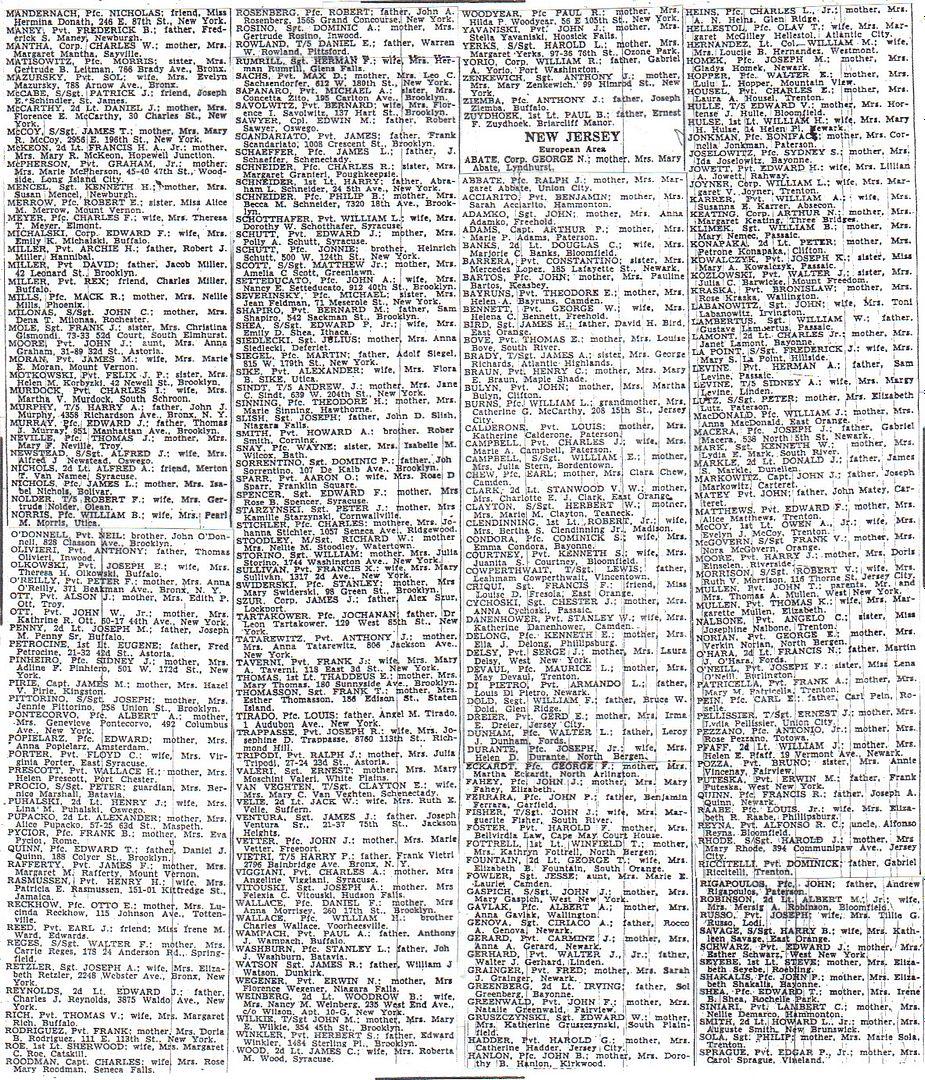
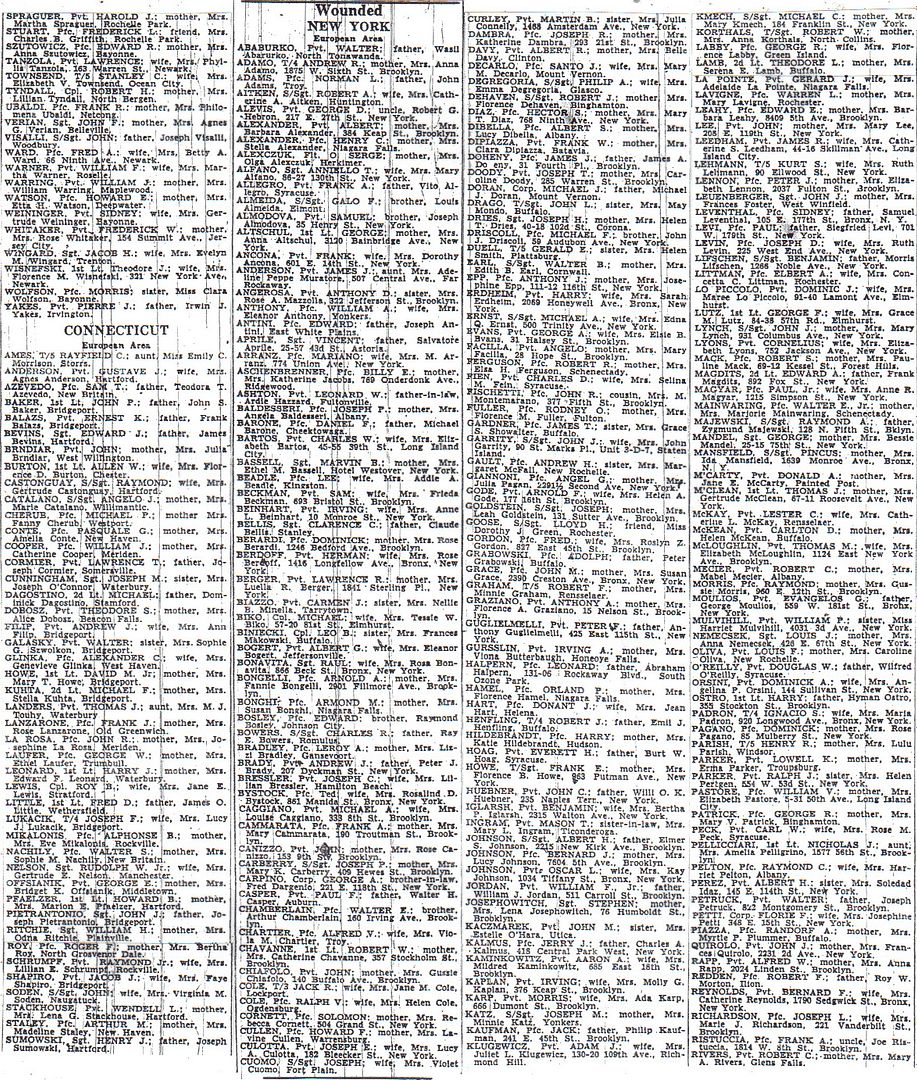
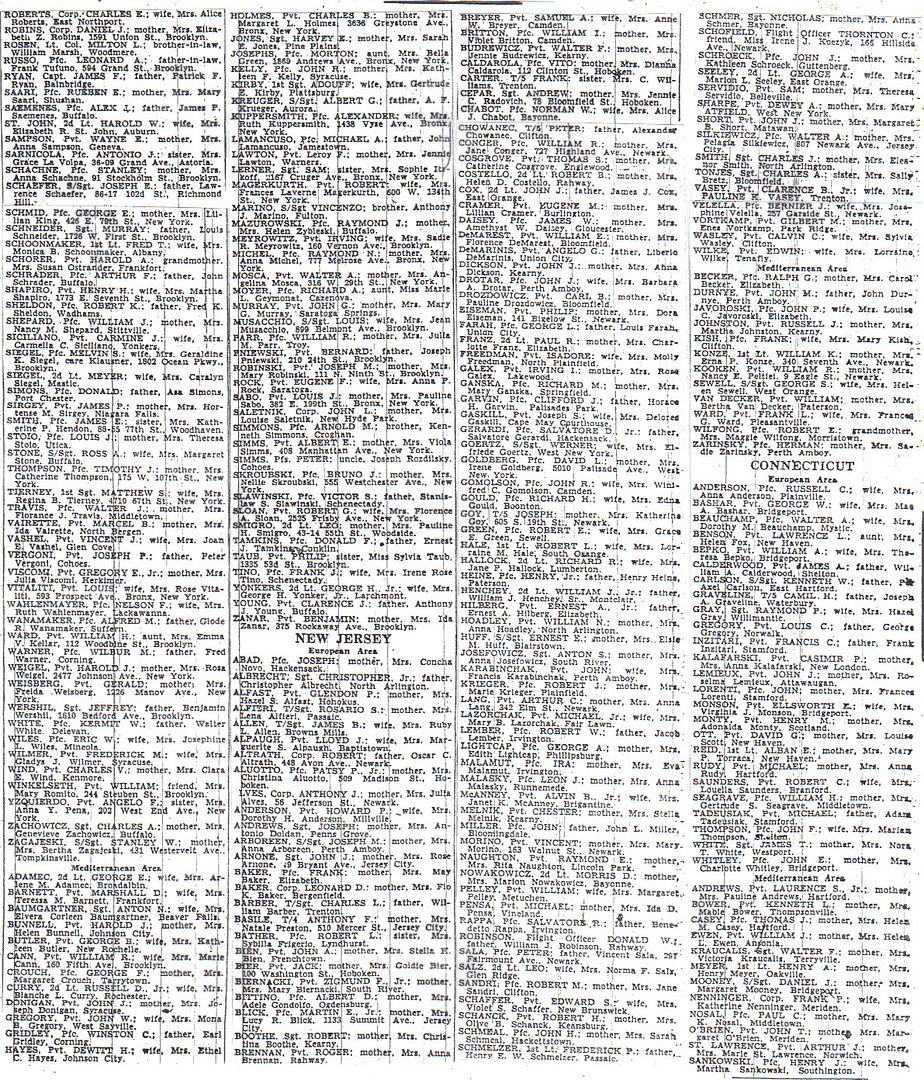

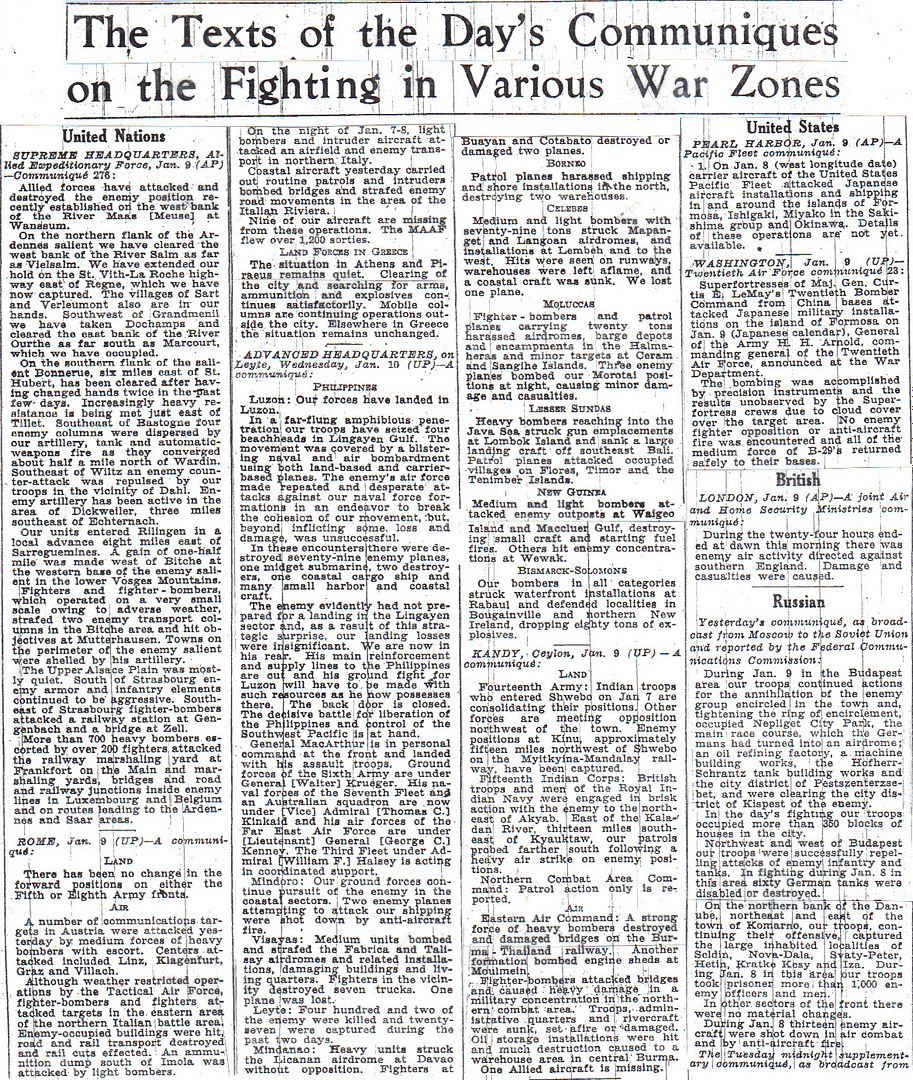
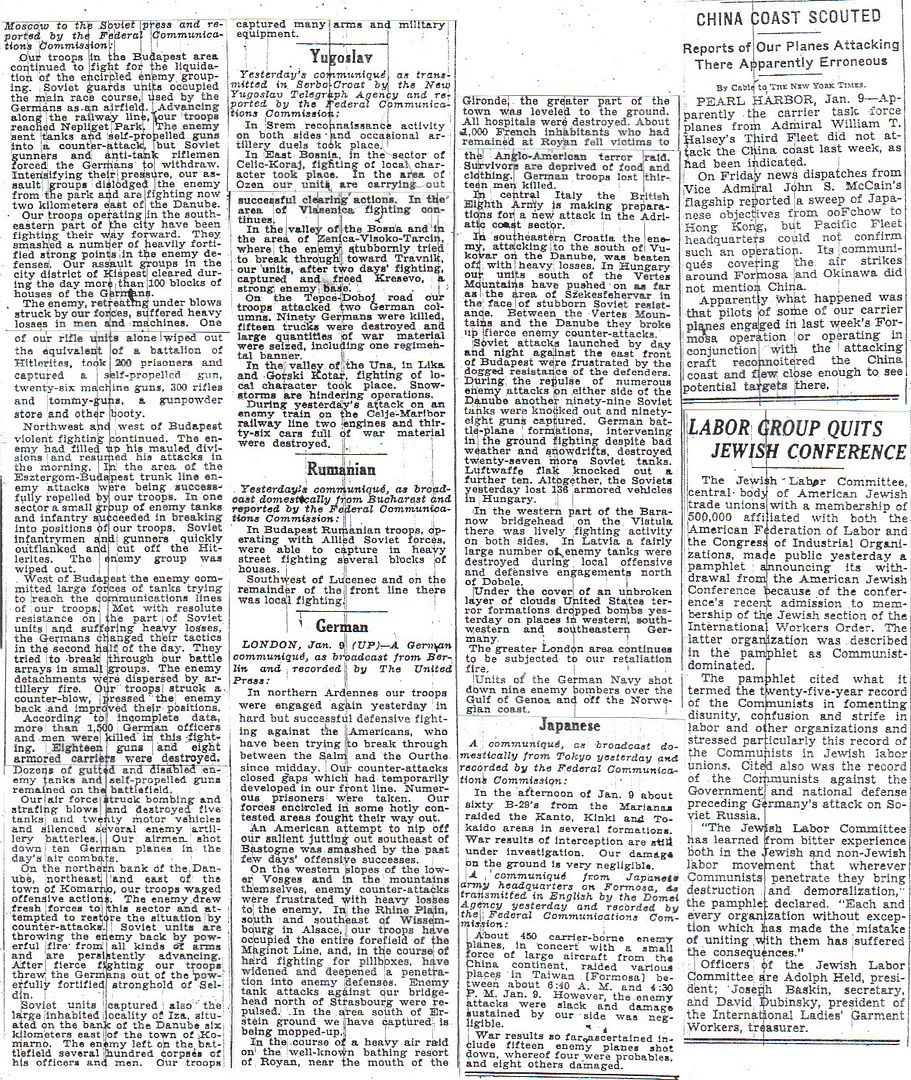
http://www.etherit.co.uk/month/0/10.htm
January 10th, 1945 (WEDNESDAY)
WESTERN EUROPE: The USAAF Ninth Air Force’s XIX Tactical Air Command flies patrols, attacks bridges and other targets and supports the US III, VIII, XII, and XX Corps in the Saint-Hubert, Belgium-Bastogne, Belgium-Wiltz, Luxembourg area, in the Diekirch and Echternach area of Luxembourg and points to the southeast.
BELGIUM: The British Second Army’s XXX Corps, the 51st Division, which has taken over the attack from the 53d, attacks near Laroche in the Ardennes. The US 1st and 3rd Armies also continue their advances.
In the U.S. Ninth Army’s XIX Corps area, the 78th Infantry Division, in a local attack, reaches the slopes of the hills overlooking the Kall River.
The U.S. First Army prepares to broaden their attack on 13 January, the VII Corps thrusting toward the line Houffalize-Rovigny and the XVIII Corps toward St Vith. In the VII Corps area, most of the Laroche-Salmchteau road, the intermediate objective of the corps, is cleared. The 84th Infantry Division patrols toward Laroche. The 2d Armored Division captures Samur and clears the Laroche-Salmchâteau road within its zone. The 83d Infantry Division takes Bihain, advances slightly in the region north of Petite Langlir, and crosses the Ronce River east of Petite Langlir. In the XVIII Corps (Airborne) area, elements of the 82d Airborne Division secure a bridgehead across the Saim River near Grand Halleux.
In the U.S. Third Army’s VIII Corps area, the 87th Infantry Division captures Tillet. Renewing their attack toward Noville, the 101st Airborne Division clears a portion of Bois Jacques; 4th Armored Division units, having passed through the 6th Armored Division, attack northeast with elements of the 101st Airborne Division toward Bourcy but cease their attack upon order. The III Corps continues their attack, with the greatest progress on the right (east) flank. On the left flank, the 6th Armored Division furnishes fire support for neighboring VIII Corps units and outposts in the northern sector of the line reached by the 4th Armored Division. Elements of the 35th Infantry Division take Villersla-Bonne-Eau and the high ground northwest. Betlange falls to the 6th Cavalry Squadron.
Four USAAF Eighth Air Force B-17 Flying Fortresses bomb a German Army supply dump at St. Vith.
FRANCE: Master Sergeant Vito R. Bertoldo, US Army, Company A, 242d Infantry, 42d Infantry Division, fights with extreme gallantry while guarding two command posts against the assault of powerful infantry and armoured forces which had overrun the battalion’s main line of resistance. (MOH) ( Drew Philip Halévy)
In the U.S. Seventh Army’s VI Corps area, elements of the 45th Infantry Division enter Althorn, on the left flank of the Bitche salient, but are unable to clear it. Otherwise, the salient is unchanged despite continued fighting about its perimeter. On the 79th Infantry Division’s northern flank, indecisive fighting occurs at Hatten; a battalion of the 315th Infantry Regiment is committed there and the 2d Battalion, 242d Infantry Regiment, recalled; another battalion of the 315th assembles in Rittershoffen. To the south, the Germans maintain the Gambsheim bridgehead. Elements of Combat Command B, 12th Armored Division, are virtually surrounded at Herrlisheim, but tanks sever the German lines in order to reinforce infantry within the town.
LUXEMBOURG: In the U.S. Third Army’s III Corps area, Harlange falls to the 28th Cavalry Squadron. One 90th Infantry Division regiment advances from Berle to the heights overlooking Doncols; another fights indecisively for the Trentelhof strongpoint. Elements of 26th Infantry Division reach the high ground southwest of Winseler.
GERMANY: GenMaj. Adolf Galland takes command of JV-44 (Jagdverband 44), the Luftwaffe. (Russ Folsom)
U-3032, U-3527, U-3528 launched
U-2531, U-4701 commissioned.
The USAAF Eighth Air Force flies Mission 789: 1,119 bombers and 362 fighters are dispatched to attack airfields, rail targets and bridges in Germany; most attacks are made using PFF methods; they claim 3-0-0 Luftwaffe aircraft; ten bombers and two fighters are lost. The targets are (numbers in parenthesis indicate number of aircraft bombing and number lost, e.g., 97-1):
- Airfields: Odendorf A/F at Euskirchen (96-0), Ostheim A/F at Cologne (83-0), Hangelar A/F at Bonn (65-2) and Gymnick A/F (51-1).
- Highway Bridges: Dusseldorf (55-2), Schonberg (55-0), Weweler (43-0), Dasburg (33-0), Rodenkirchen(30-0) and Deutz (12-1) at Cologne, Steinbruck (25-0).
- Marshalling yards: Karlsruhe (106-0), Gereon (43-2) and Nippes (23-0) at Cologne, and Duren (13-0).
- Railroad Bridges: Hohenzollern (52-1) and South (35-1) at Cologne, and Rheinhausen at Duisburg (11-0).
Sixty three other aircraft bomb targets of opportunity.
During the night of 10/11 January, RAF Bomber Command Mosquitos bomb two targets: 50 hit Berlin and three bomb Cologne.
ITALY: Weather restricts operations by the USAAF Twelfth Air Force but fighter-bombers effectively attack communications and supply dumps in the central and northern Po Valley; the strikes are concentrated in the north and around Piacenza, and score nearly 50 rail cuts, along with destruction of 80 motor transports and several trains; fuel and ammunition dumps in the Milanarea are bombed and a 400-foot (122 meter) naval vessel at Venice is destroyed. During the night of 10/11 January, A-20 Havocs attack targets of opportunity in the western Po Valley .
YUGOSLAVIA: Island of Ist in the ADRIATIC SEA: Signalman Kenneth Smith (b.1920), Royal Corps of Signals, carried a bomb from a house containing children; it blew up, killing him. (George Cross)
CHINA: In an effort to reopen the Canton-Hengyang stretch of the Canton-Hankow Railroad, the Japanese move forward as quietly as possible about this time.
BURMA: The British XXXIII Corps advances to the Irrawaddy River. The IV Corps moves south to the west of the Chindwin River taking Gangaw.
Whilst the advance of the Indian XXXIII Corps to the Irrawaddy River is attracting the Japanese attention, the Indian IV Corps is moving southward to the west of the Chindwin with the intention of crossing the Irrawaddy near Meiktila. Gangaw is taken in this advance. The Indian 19th Division takes bridgeheads over the Irrawaddy north of Mandalay, at Kyaukmyang and Thabeikkyin. Fierce Japanese attacks in these areas begin immediately. In the Arakan, there are landings of British Commandos near Myebon on the mainland between Akyab and Ramree.
In the Northern Combat Area Command area, the 114th Regiment of the Chinese 38th Division, which is to move around the southern end of the Shweli Valley and cut the Namhkam-Namhpakka trail, crosses the Shweli River. The U.S. 124th Cavalry Regiment (Special), after a delay at the Shweli River because of swollen waters, is assembled east of the river.
Seventy five USAAF Tenth Air Force fighter-bombers attack troop concentrations, supplies, tanks, artillery, and buildings at Kawnglang, Nampa-chi, Man Namman, Pangkai, Mong Yai, Namhsan, Namyao, Se-ping, Panghai,and in the Hosi area; 17 P-47 Thunderbolts knock out a bridge, damage another at Bawgyo and two others at Ho-kho; eight P-47s support ground forces in the Si-U battle sector and eight others hit supplies and ferry crossing at Ta-mawngtawn.
Over 50 USAAF Fourteenth Air Force P-51 Mustangs, P-40s, and P-38 Lightnings attack various targets of opportunity throughout the Wanling area and six P-40s hit targets of opportunity in the Muse area.
FRENCH INDOCHINA: Two USAAF Fourteenth Air Force B-24 Liberators bomb the Cap-Saint-Jacques area.
JAPAN: Three USAAF Eleventh Air Force B-24 Liberators on an armed photo mission bomb and photograph Kurabu Airfield on Paramushiru Island, Kurile Islands, scoring hits on the runway.
COMMONWEALTH OF THE PHILIPPINES: In U.S. Sixth Army area on Luzon, army reserve begins landing. In the XIV Corps area, the 185th Infantry Regiment, 40th Infantry Division takes Labrador while the 160th Infantry Regiment pushes along Highway 13 toward Aguilar, reaching the Umanday area. Because of a gap developing between the two regiment, the 180th Infantry Regiment (less 3d Battalion) is committed in the Polong area. The 148th Infantry Regiment, 37th Infantry Division, speeds inland to San Carlos; elements continue to the Army Beachhead Line. One 129th Infantry Regiment column moves without opposition to Malisiqui, within 2.5 miles (4,0 kilometers) of the Army Beachhead Line, while another reaches the Army Beachhead Line at Dumpay and maintains contact with the 148th Infantry Regiment. In the I Corps area, the 6th Infantry Division drives south and southeast to Mapandan and the vicinity of Santa Barbara. The 43d Infantry Division’s 103d Infantry Regiment takes San Jacinto without oppos ition and pushes on toward Manoag and Hill 200; the 169th and a 172d Infantry Regiments run into organized defense positions on hills confronting them; the 169th takes Hill 470 and drives on Hill 351 and 318; the 172d clears Hill 385 and moves slowly toward Hill 351.
On Luzon, USAAF Far East Air Forces B-24 Liberators bomb Grace Park Airfield and warehouse area near Manila, A-20 Havocs and fighter-bombers attack trucks, trains, railroad yards, railroads, and highways over wide areas of northern and southern Luzon, and bomb Vigan and Laoag Airfields. Other B-25 Mitchells, A-20 Havocs, and fighter-bombers, operating in smaller forces, hit numerous shipping and communications targets, airfields, and other targets throughout the Philippine Islands.
Japanese assault demolition boats infiltrate the transport areas off Lingayen, sinking an infantry landing craft (mortar) and an infantry landing craft (gunboat), and damaging destroyers USS Robinson (DD-562) and Philip (DD-498), transport USS War Hawk (AP-168) and tank landing ship USS LST-610. Japanese air attacks against the fleet off Lingayen continue, damaging destroyer USS Wickes (DD-578); kamikazes damage destroyer escort USS Leray Wilson (DE-414), and attack transport USS Dupage (APA-41).
NETHERLANDS EAST INDIES: U-510 sailed from Jakarta on her final patrol.
In the Netherlands East Indies, about 60 USAAF Far East Air Forces P-40s bomb and strafe the Galela area on Halmahera Island and B-25 Mitchells and P-38 Lightnings hit Kendari Airfield on Celebes Island.
AUSTRALIA: Since censorship has prevented the press from publishing news that Australian troops have taken over from the Americans on Bougainville Island, Solomon Islands, the Canberra Times newspaper asks, “Will anyone knowing the whereabouts of Australian soldiers in action in the South West Pacific Area please communicate at once with the Australian Government”
CAROLINE ISLANDS: Two USAAF Seventh Air Force B-24 Liberators, on armed reconnaissance, hit the airfield on Woleai Atoll.
VOLCANO ISLANDS: Thirty USAAF Seventh Air Force B-24 Liberators operating in two separate formations, bomb airfields on Iwo Jima; airfields are hit again on the night of 10/11 January by B-24s flying snooper missions from Guam.
U.S.A.: Douglas DC-3-277B, msn 2215, registered NC25684 by the U.S. airline American Airlines, crashes into the Verdugo Mountains at 0410 hours local while attempting to land at Palmdale Airport, California. This is American Flight 6001 from New York City to Burbank, California, via Juarez, Mexico. The aircraft, lost in fog, crashes while attempting to reach Palmdale, its alternate landing site, after being unable to land at Burbank Airport. The company ground personnel fail to obtain and transmit important weather information to the pilot and he improperly executed a missed approach. Movie actress Donna Reed was returning from Juarez where she obtained a divorce from her husband, makeup artist William Tuttle, but is bumped from the flight just prior to takeoff to make room for a military officer holding a wartime-travel priority pass. All 21 passengers and three crew aboard are killed.
Three Japanese Fu-Go paper balloon are recovered today.
- The first balloon, including envelope, rigging and apparatus, is forced down by a USN aircraft at 1750 hours local about 30 miles west of Alturas, California. Alturas is located in northeastern California about 114 miles (183 kilometers) northeast of Redding.
- The second balloon is found near Bozeman, Montana; it is not known when the balloon landed. Bozeman is located about 123 miles (198 kilometers) west of Billings.
- Remnants of a third balloon are found near Lake of the Woods, Oregon. The date of the landing is unknown. Lake of the Woods is located about 215 miles (346 kilometers) south-southeast of Portland.
Heavy cruiser USS Chicago commissioned.
ATLANTIC OCEAN: At 1603, SS Blackheath in Convoy KMS-76 (the convoy was combined with OS-102) was torpedoed and damaged by U-870 west of Gibraltar. She was set aground two miles south of Cape Spartel, Algeria, but broke in tow and was declared a total loss. Frigate HMS Ballinderry and sloop HMS Kilbirnie picked up the master, 41 crewmembers and nine gunners. Landed at Gibraltar.
Note with everything going on in the Philippines, Burma, the air space over Japan and the like the mention of a request to CincPac for some mines in Cam Ranh Bay - I wonder if at the time anybody thought at the time we’d be back there in force just a couple of decades later.
“Nazi Bulge Sagging”
A very evocative headline!
I see on page 10 that mink prices are down 30%, but subject to 20% Federal tax. Not much of a bargain, even for the Precious Wild Labrador Mink.
Interesting bits pushing paper recycling at the bottom of page 11:
“One old envelope per day from seven million New Yorkers will make 75,000 blood plasma containers. Save yours.”
“Scrap paper is precious — the armed forces urgently need it. Save yours. Keep it clean.”
Before Christmas, those little spaces had plugs about helping the “Hundred Neediest Cases” or something like that. I wonder how that turned out.
Well, liberation is coming.
But the price will be very high, especially for the Filipinos.
Damn Japs.
Good morning. Well said!
VOLCANO ISLANDS: Thirty USAAF Seventh Air Force B-24 Liberators operating in two separate formations, bomb airfields on Iwo Jima; airfields are hit again on the night of 10/11 January by B-24s flying snooper missions from Guam.
I notice these are mostly activity reports that do not show results of missions. Would results have been reported else where?
In WW II, both sides regularly targeted airfields -- but to little effect.
Cratered runways could be readily re-filled, re-built and returned to service. The only meaningful targets were the planes and their crewmen -- which, after the early stages of the war, were dispersed
Disclaimer: Opinions posted on Free Republic are those of the individual posters and do not necessarily represent the opinion of Free Republic or its management. All materials posted herein are protected by copyright law and the exemption for fair use of copyrighted works.